I often accidentally overwork the drawing during live model sessions,
so the girl’s face ends up looking like she has a beard,
or the wrinkles become too strong and she looks like an old lady
Curious about the positions and roles of facial muscles, I compiled the following breakdown. If you’re interested, follow along and refer to the illustrations provided!
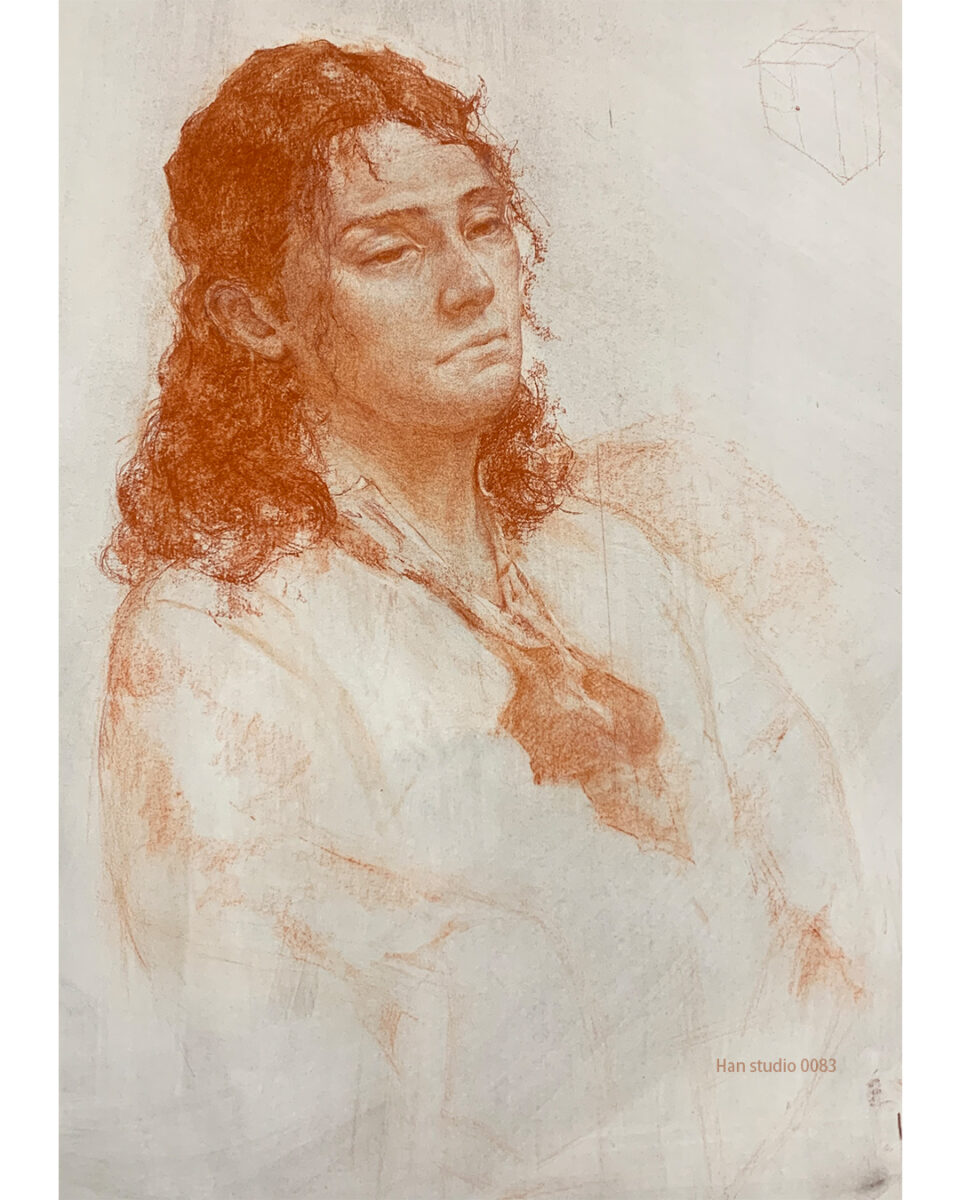
―――――――――――――――――
● Why learn facial muscles?
- The face is the main stage for emotional expression, and details can convey a character’s mood and personality.
- Drawing is not only about depicting surface shapes; it is recommended to understand the underlying logic of muscle movement.
● Introduction of main facial muscles:
Forehead area
Frontalis muscle
- Contraction forms raised brows and surprised expressions.
- Hatching direction: mainly vertical arrangement.
Location: Forehead. Function: Raises the eyebrows and creates forehead wrinkles. Often involved in expressions of surprise (wide-open eyes).
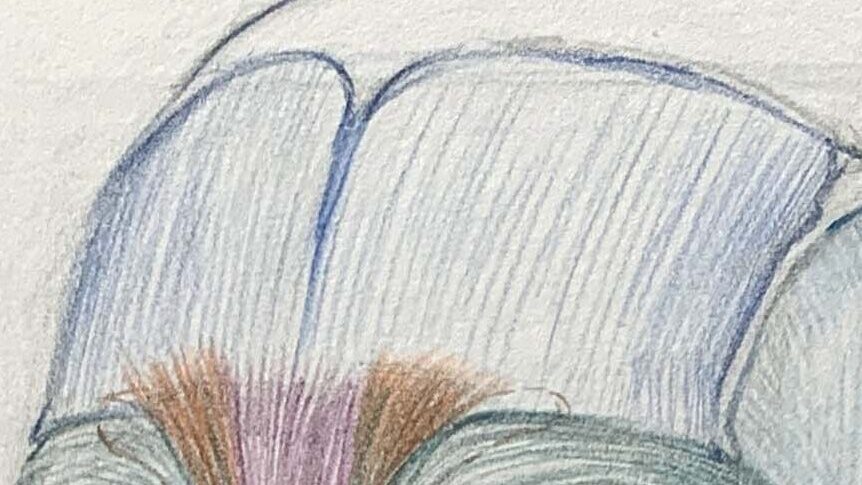
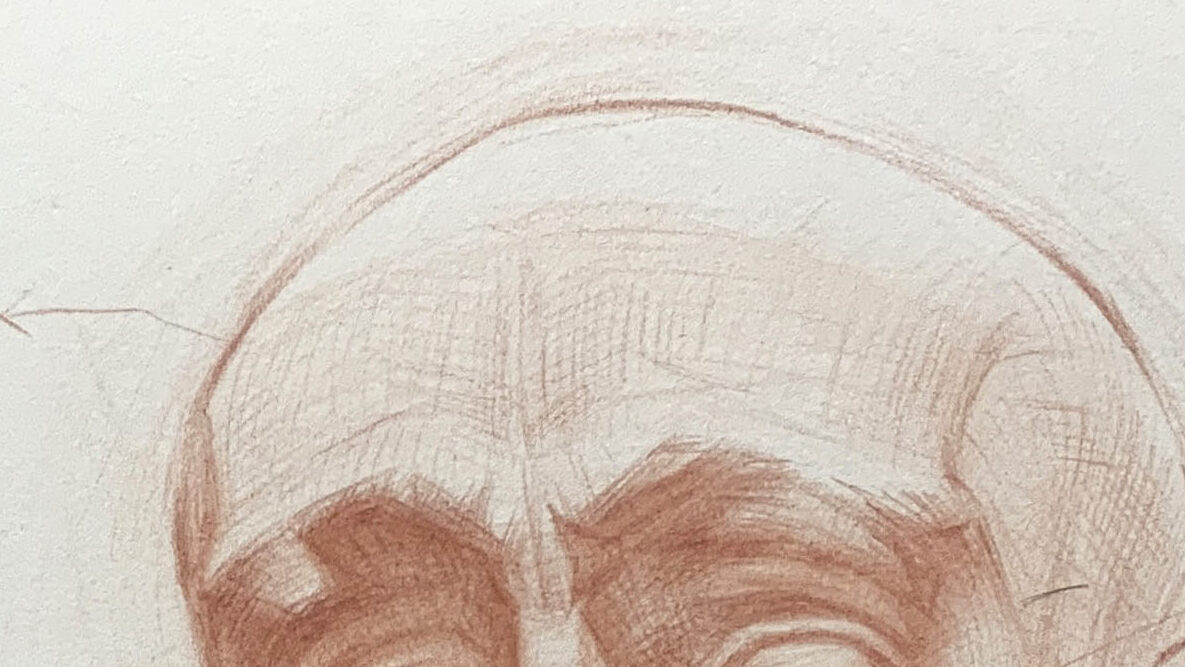
Glabella and nasal root area
●Depressor supercilii, corrugator supercilii, procerus
- Produce frowning and angry expressions.
- Hatching direction: vertically concentrated at the glabella, spreading radially.
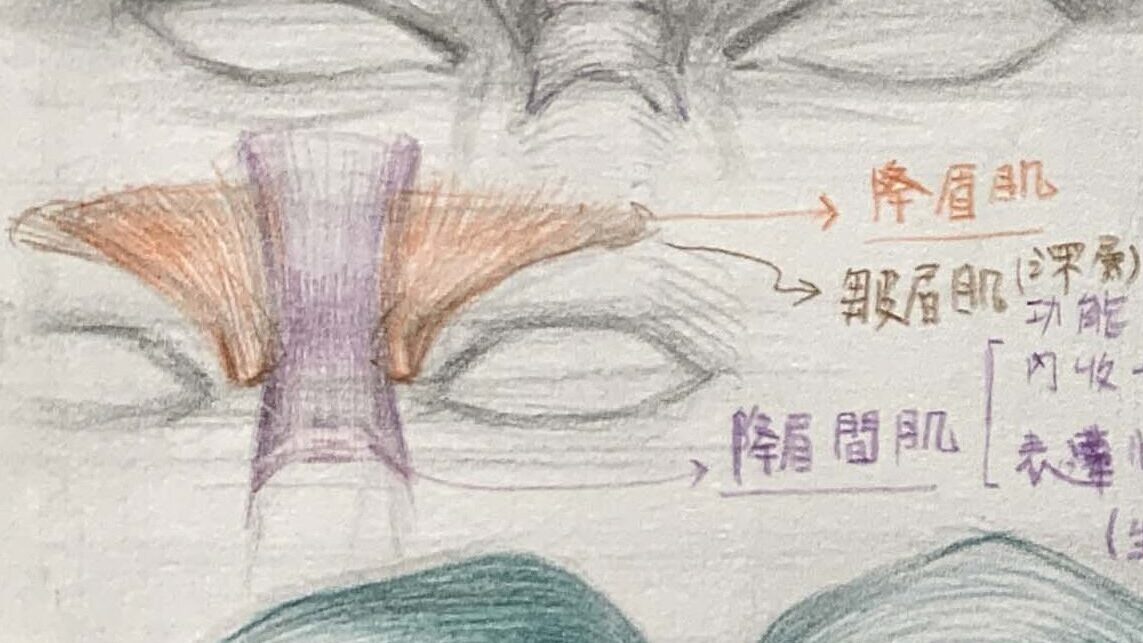
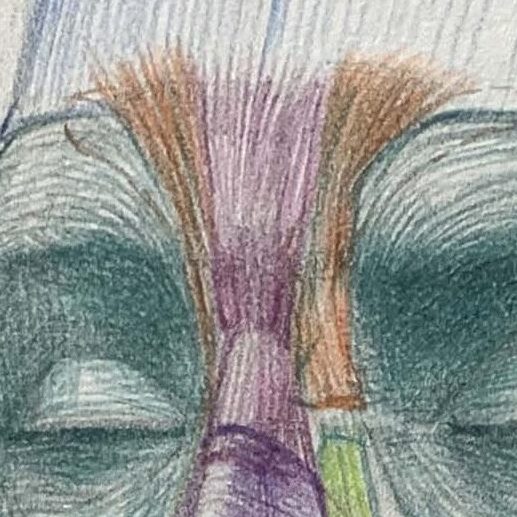
Around the eyes
● Orbicularis Oculi (Sphincter Muscle)
- Controls blinking, closing, and squinting.
- Hatching direction: circular/elliptical arrangement around the eye.
Location: Encircles the eye. Function: Closes the eyelids and controls blinking. Natural wrinkles around this area appear with smiling.
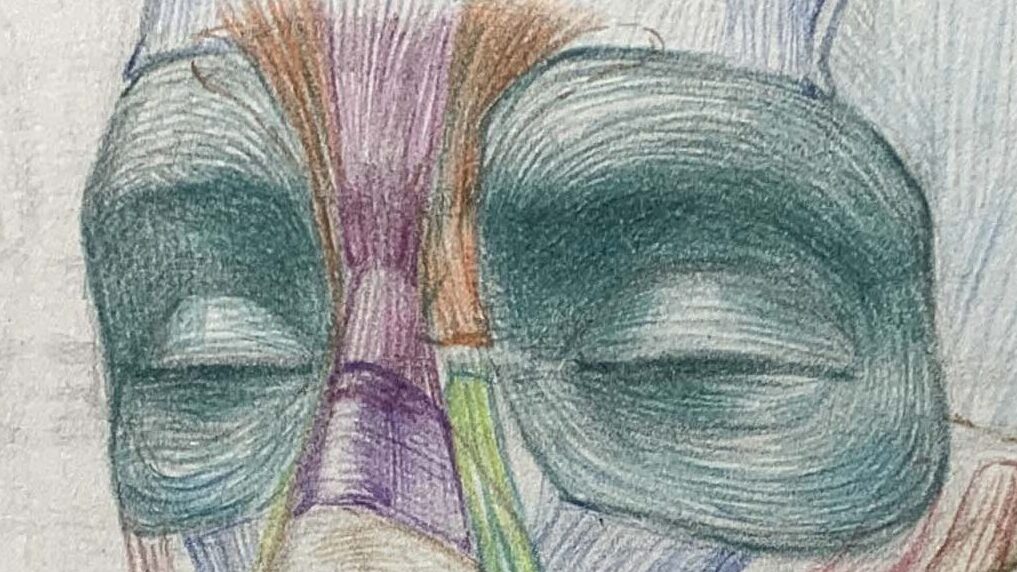
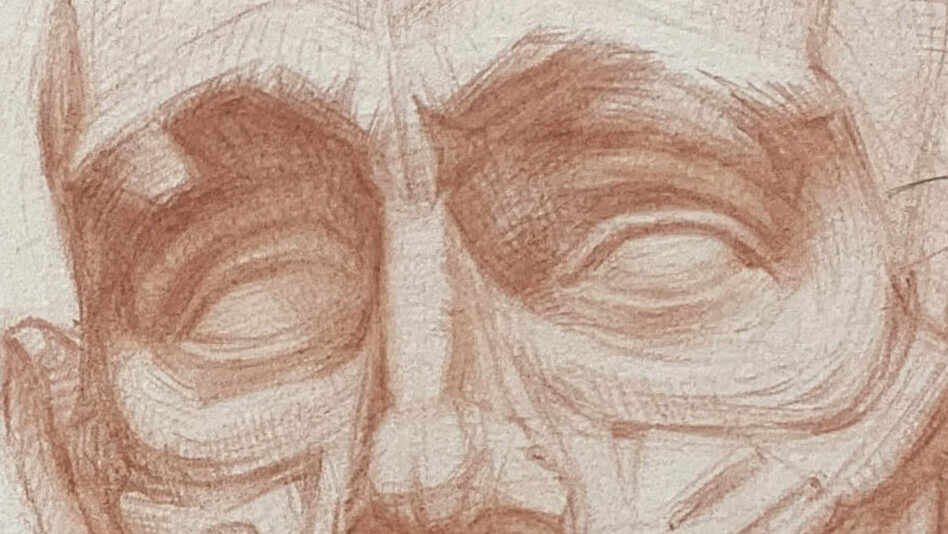
The orbicularis oculi can be divided into two main parts:
- Orbital part
| 項目 | 內容 |
|---|---|
| Origin: | (1) medial orbital margin (2) lacrimal crest (3) bony rim around the orbit |
| Insertion: | (1) lateral orbital ligament (2) interwoven with palpebral fibers to form a complete ring |
| Function of the nasal bridge | (1) forceful closure of the eye (e.g., “squeezing” the eyes, strong blinking) (2) protects the eyeball, assists tear drainage |
| Note: | Fibers radiate outward from the bone rim, converging at the lateral orbital ligament. When squinting, deep radiating wrinkles appear below the brows and above the cheeks. |
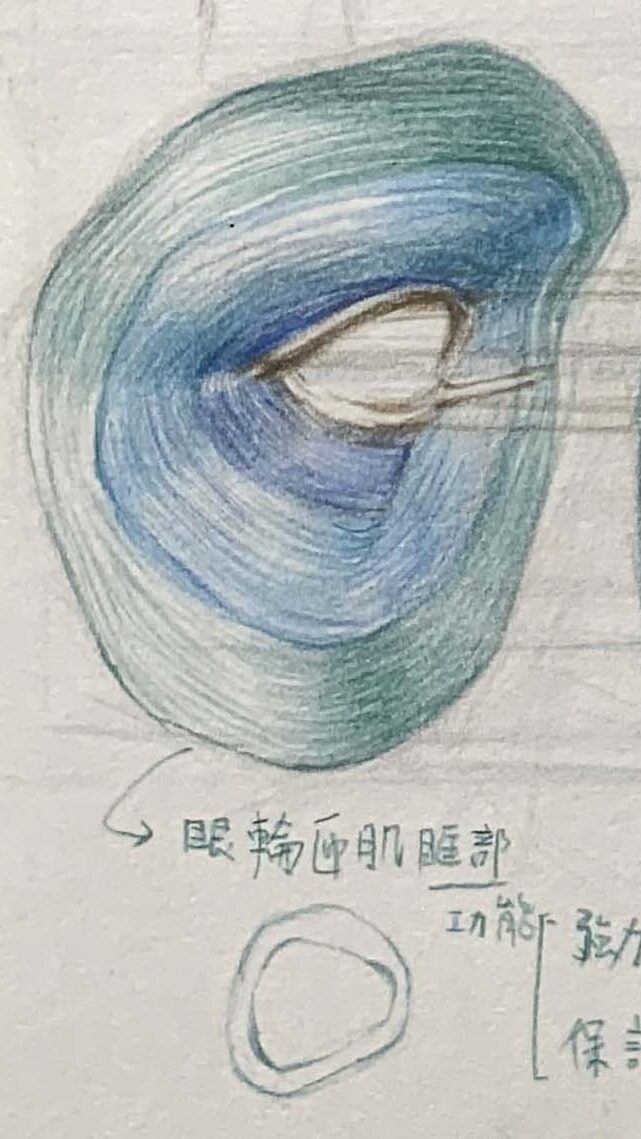
- Palpebral part
| 項目 | 內容 |
|---|---|
| Origin: | near medial palpebral ligament |
| Insertion: | lateral palpebral ligament |
| Function of the nasal bridge | gentle blinking (natural blinks without wrinkles, maintaining tear film and eyelash cleaning) |
| Note: | located above upper and lower tarsal plates, fibers run nearly horizontally. During natural blinking, only this part contracts, leaving no major wrinkles around the eyes. |
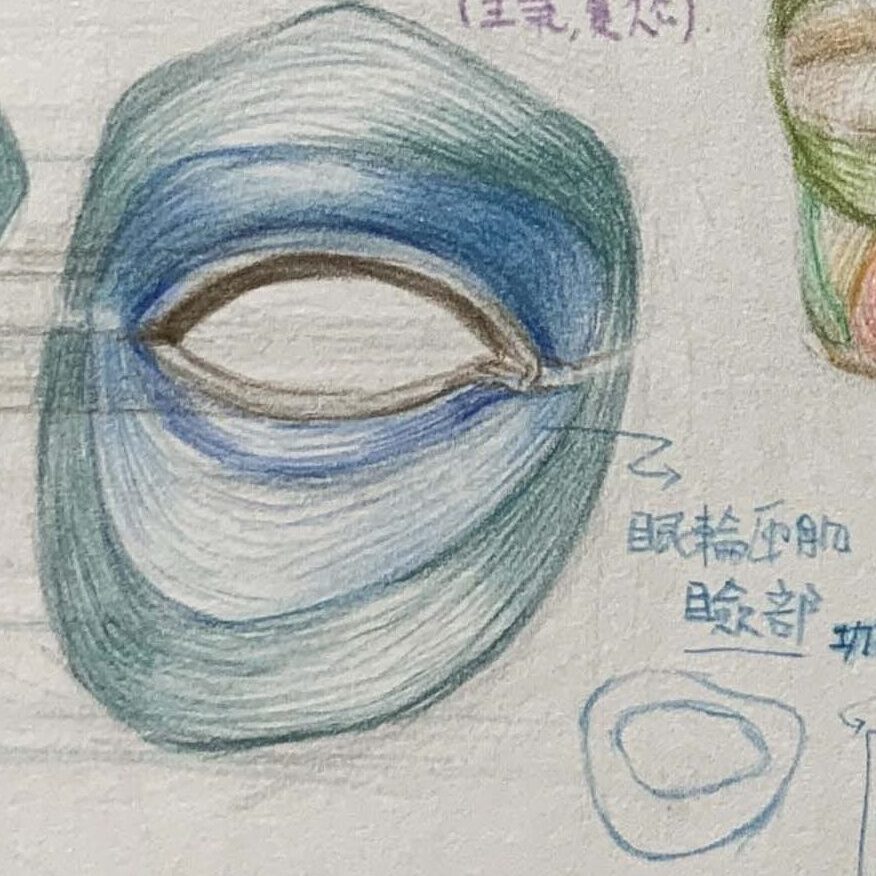
Cheek and zygomatic area
Zygomaticus major and minor
- Raise the corners of the mouth when smiling.
- Hatching direction: diagonal, from zygomatic bone down to mouth corners.
Location: Extends from the cheekbone to the corner of the mouth. Function: Elevates the corners of the mouth, creating smiles—a key muscle for depicting joyful expressions.
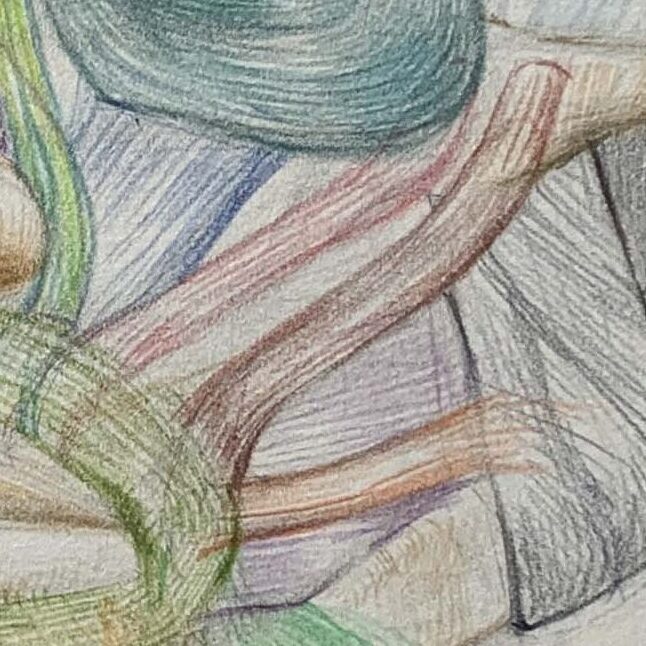
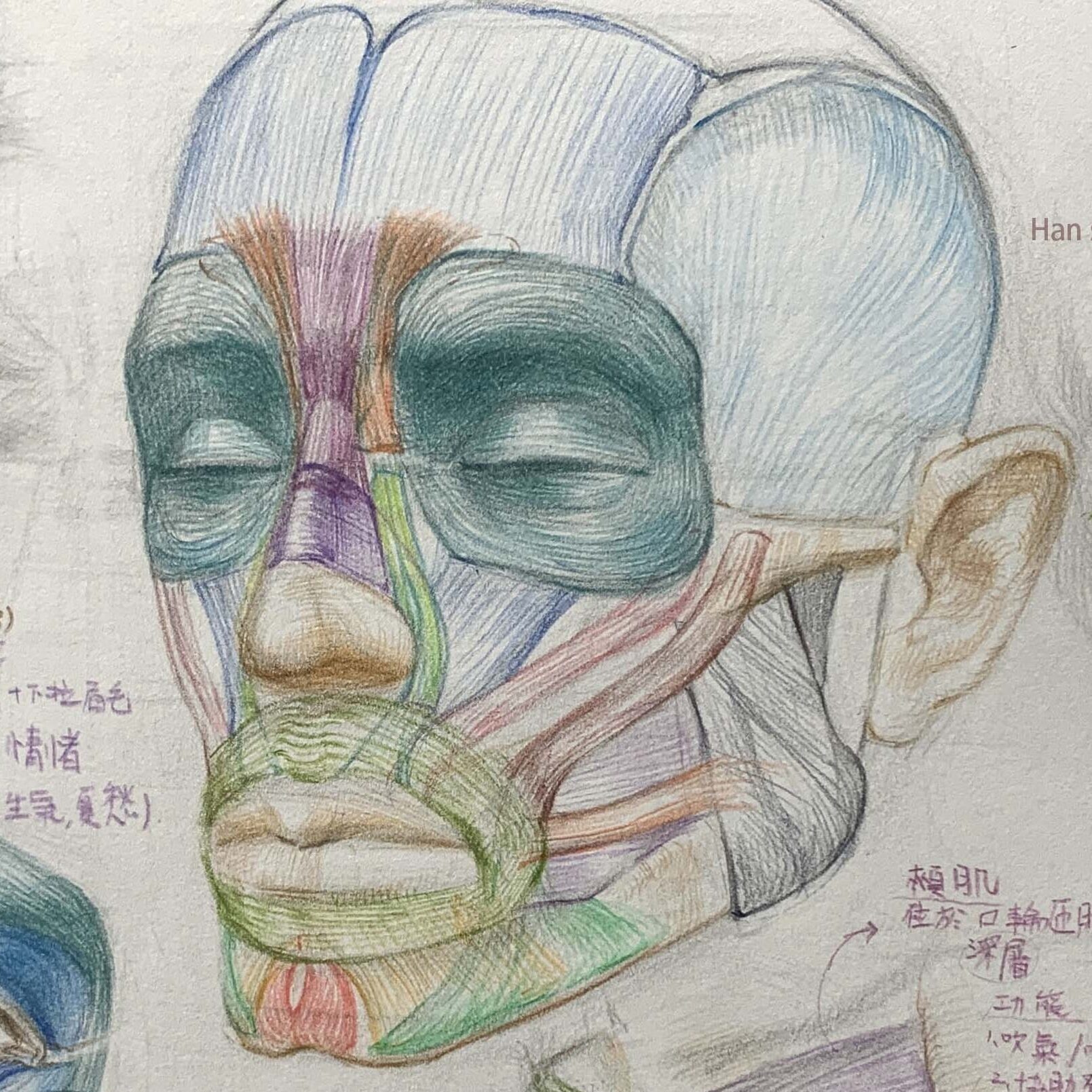
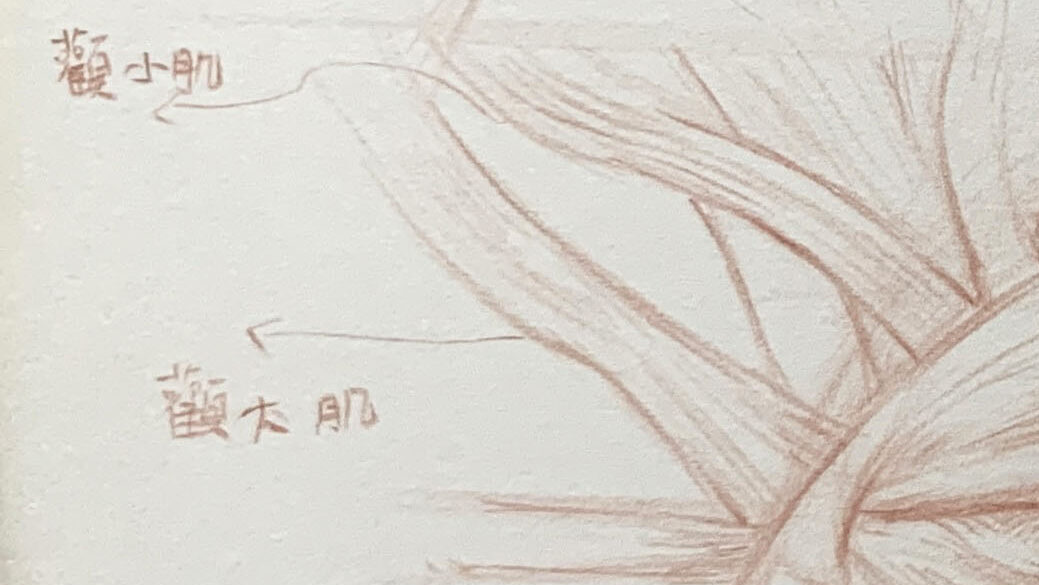
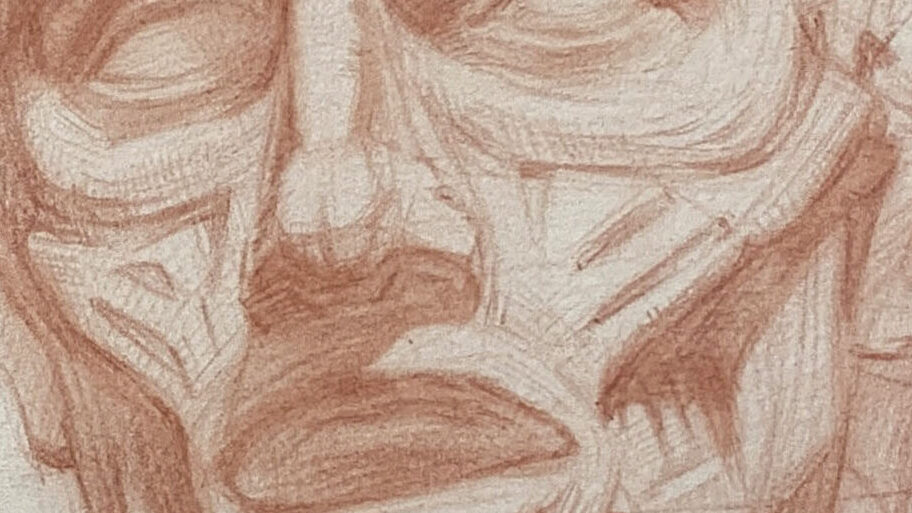
Around the mouth
● Orbicularis Oris (Sphincter Muscle)
- Puckering, lip contraction expressions.
- Unlike a simple “origin → insertion” strip muscle (skeletal muscle), the orbicularis oris consists of two fiber layers:
- Deep fibers originate from the alveolar processes of the jaws, circle around the lips, and cross to the opposite side.
- Superficial fibers converge from various facial muscles into the modiolus (mouth corner node) and circle the lips. It surrounds the lips, controlling their opening and closing, used in speech, blowing, or pouting.
Location: Surrounds the lips. Function: Controls the opening and closing of the mouth, essential for portraying speech, whistling, or puckering.
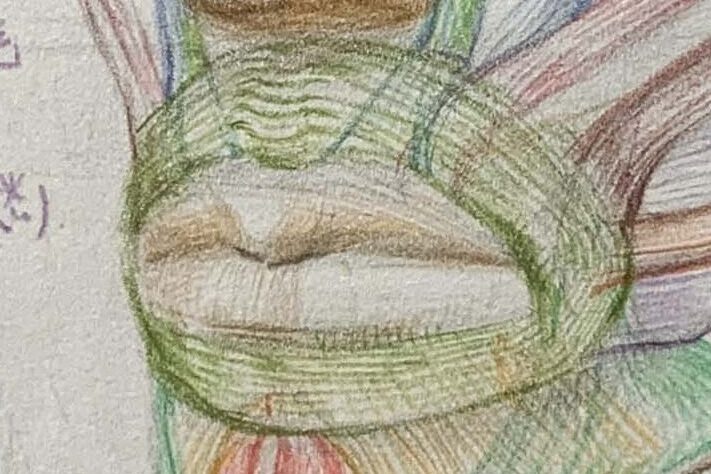
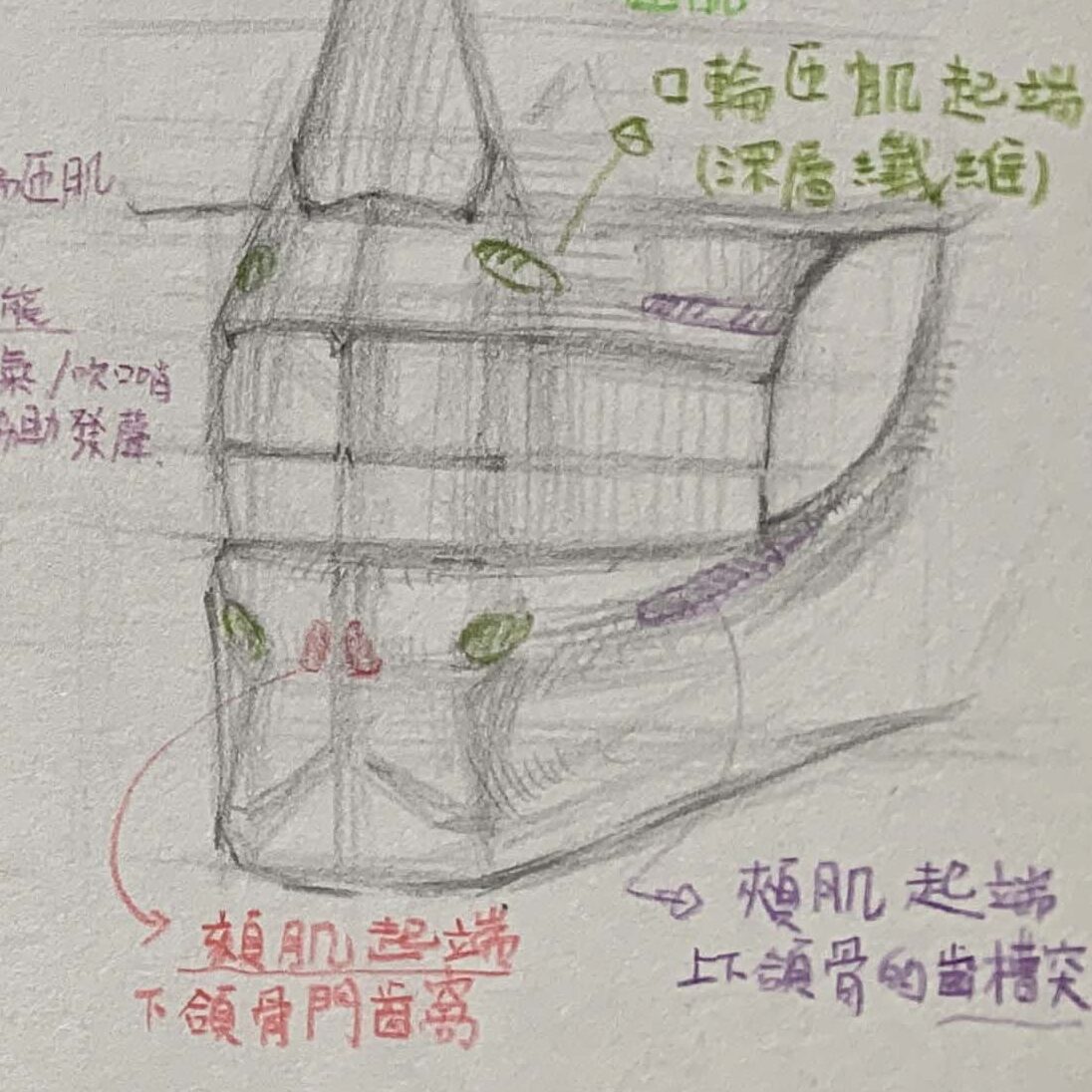
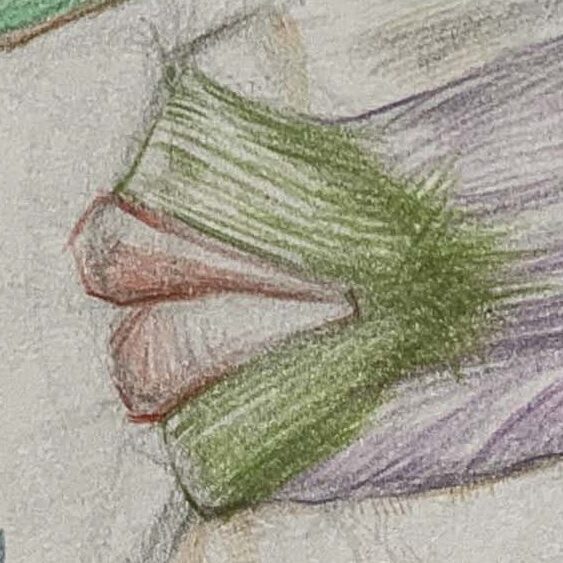
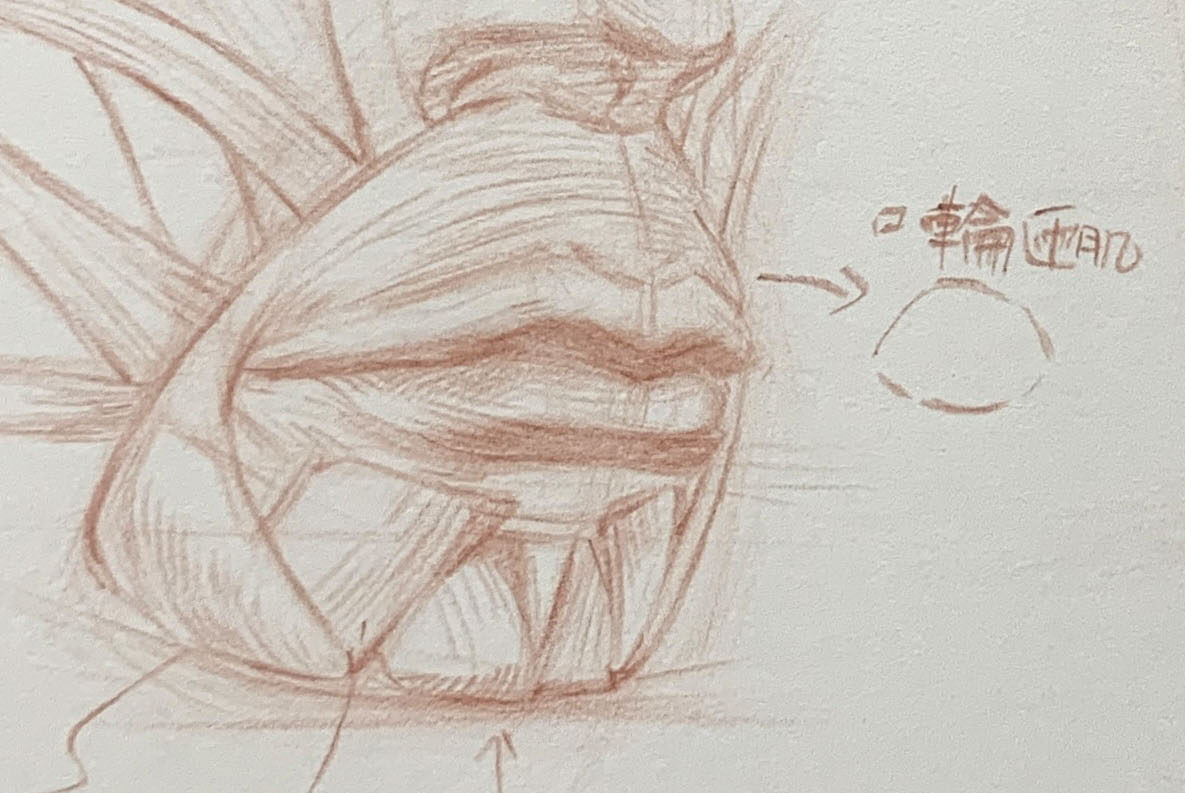
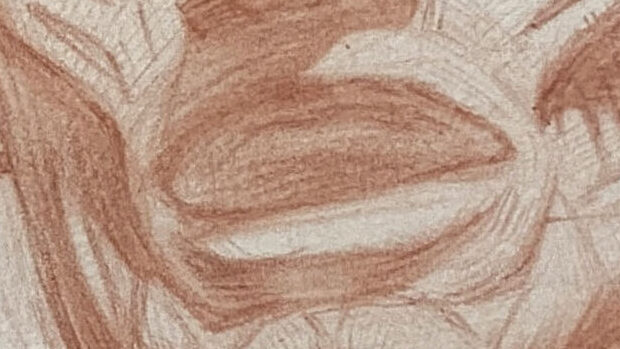
● Depressor Anguli Oris
Location: At both corners of the mouth. Function: Pulls the corners of the mouth downward, conveying sadness or dissatisfaction.
- Located at both corners of the mouth, pulling them downward to show sadness or discontent.
- Hatching direction: vertical downward from mouth corners.
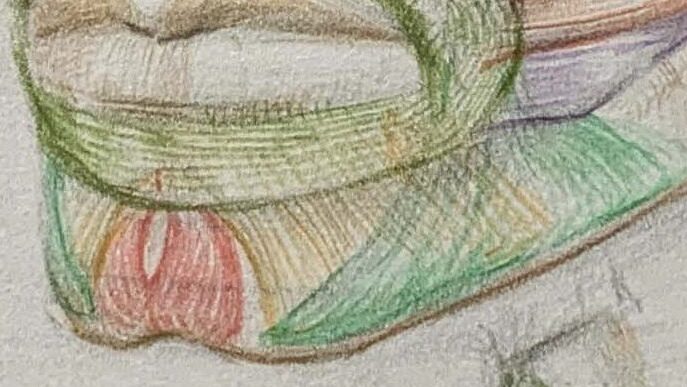
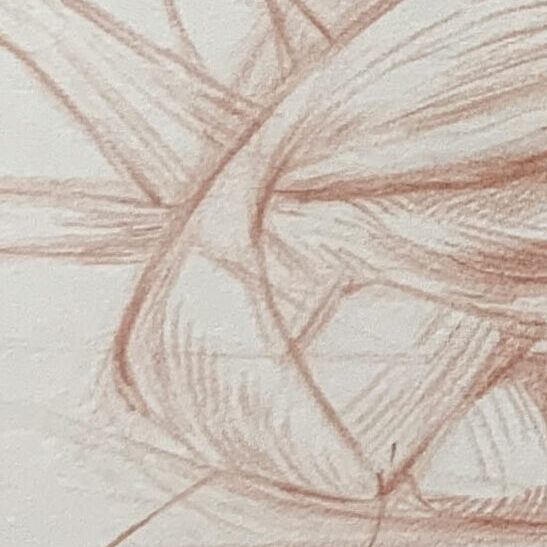
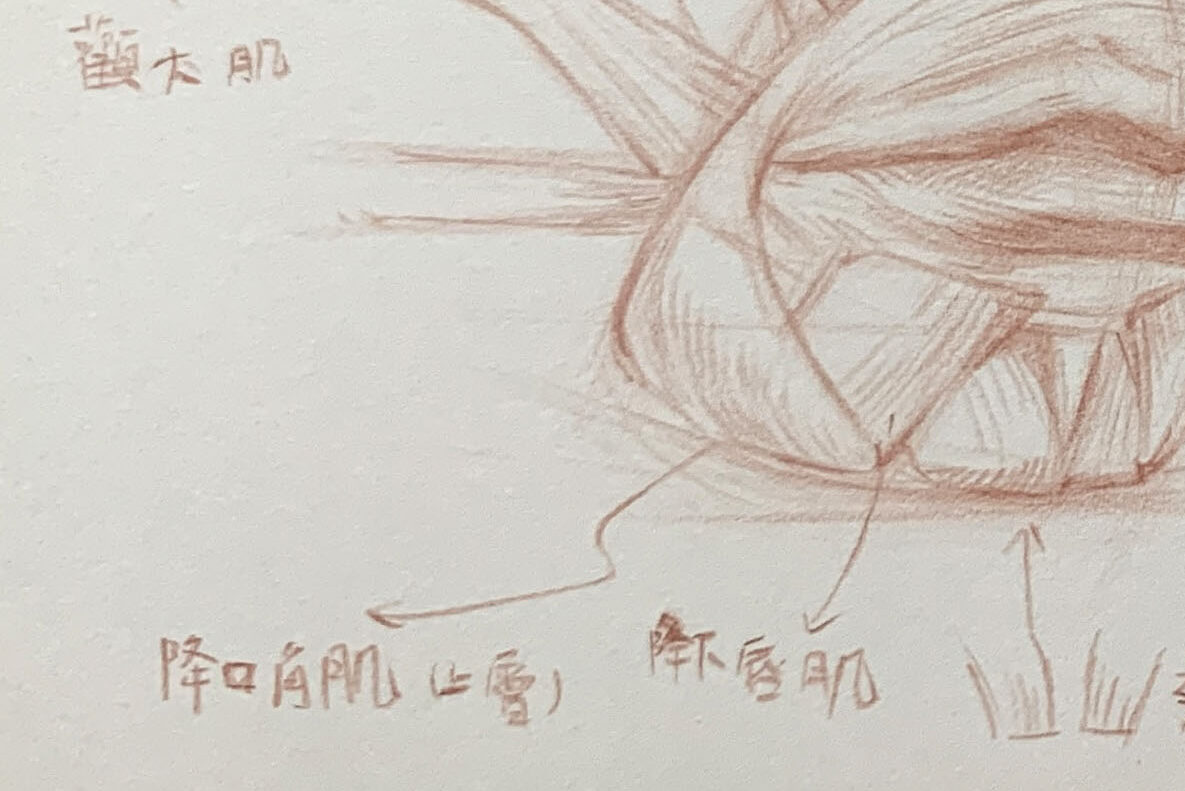
Jaw and lateral cheek area
● Masseter Muscle
- Creates a noticeable bulge when chewing, protrudes at the side of the cheek. Hatching direction: mostly vertical, emphasizing raised muscle volume.
- Located on the side of the cheek, responsible for closing the jaw. Key for chewing or clenching.
Location: Side of the face (cheek area). Function: Closes the jaw, playing a major role in chewing or clenching the teeth.
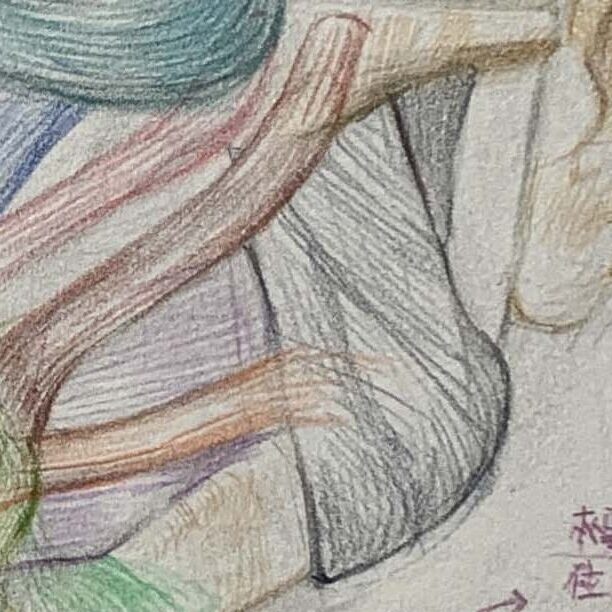
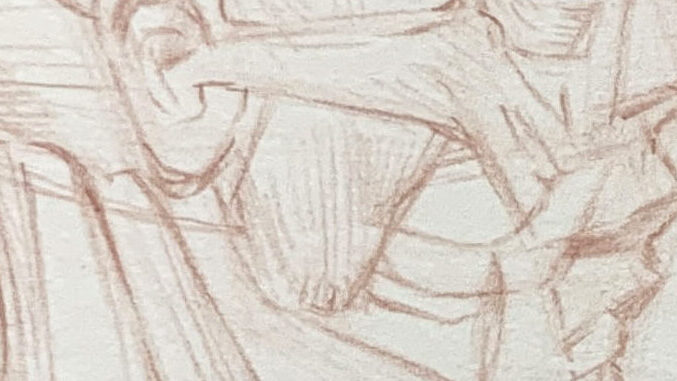
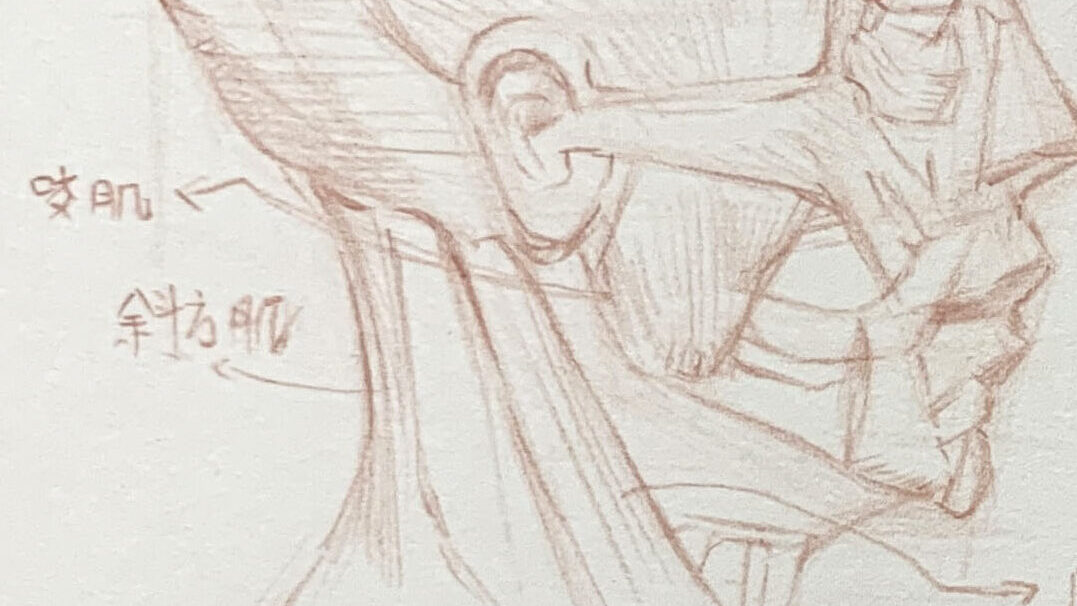
● Temporalis Muscle
Location: On the sides of the skull.
Function: Controls jaw movement, especially opening and closing.
Feature: The temporalis muscle fans out along both sides of the skull, aiding in jaw movement.
Location: On the sides of the skull.
Function: Controls jaw movement, especially opening and closing.
Feature: The temporalis muscle fans out along both sides of the skull, aiding in jaw movement.
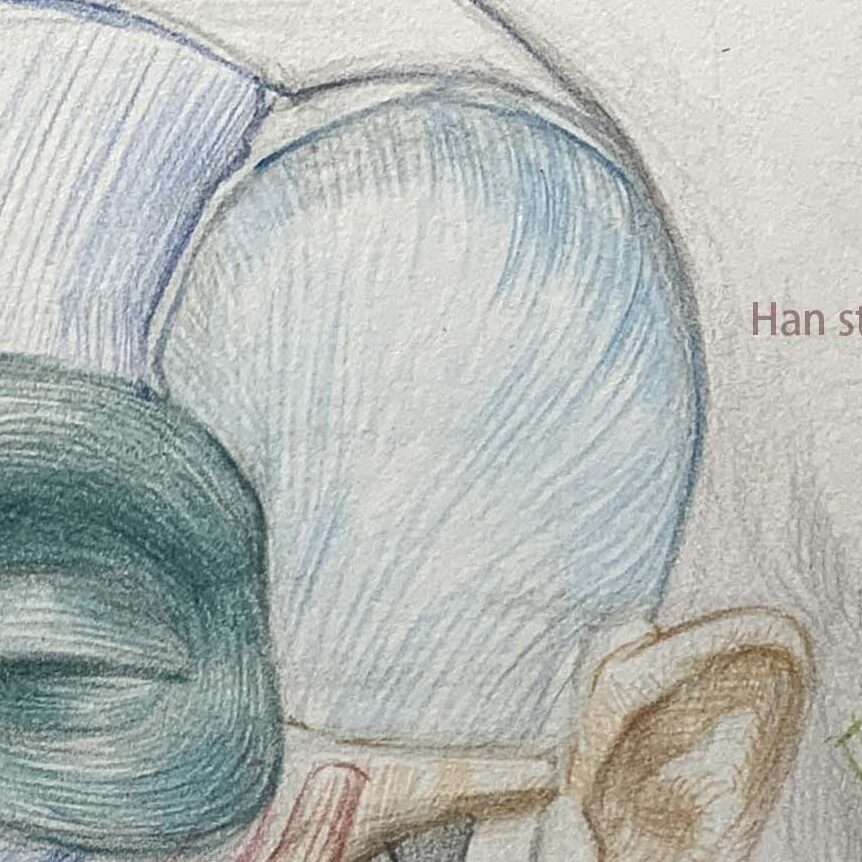
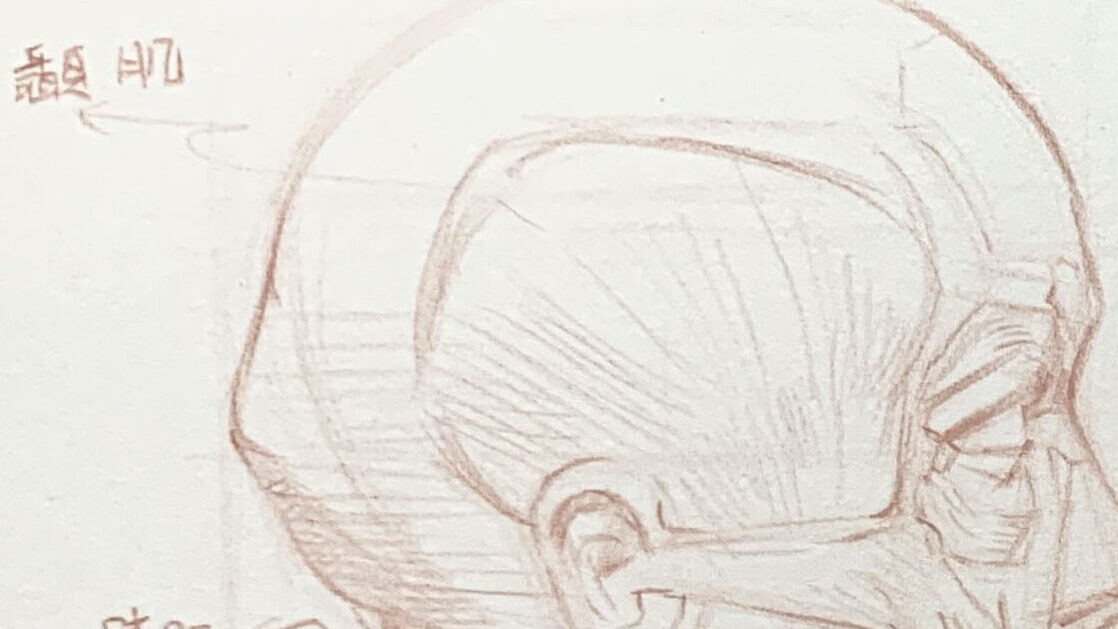
Muscle collaboration and compound expressions
Expressions are usually formed by multiple muscles working together.
Examples:
- Smile = zygomaticus major + orbicularis oris + orbicularis oculi
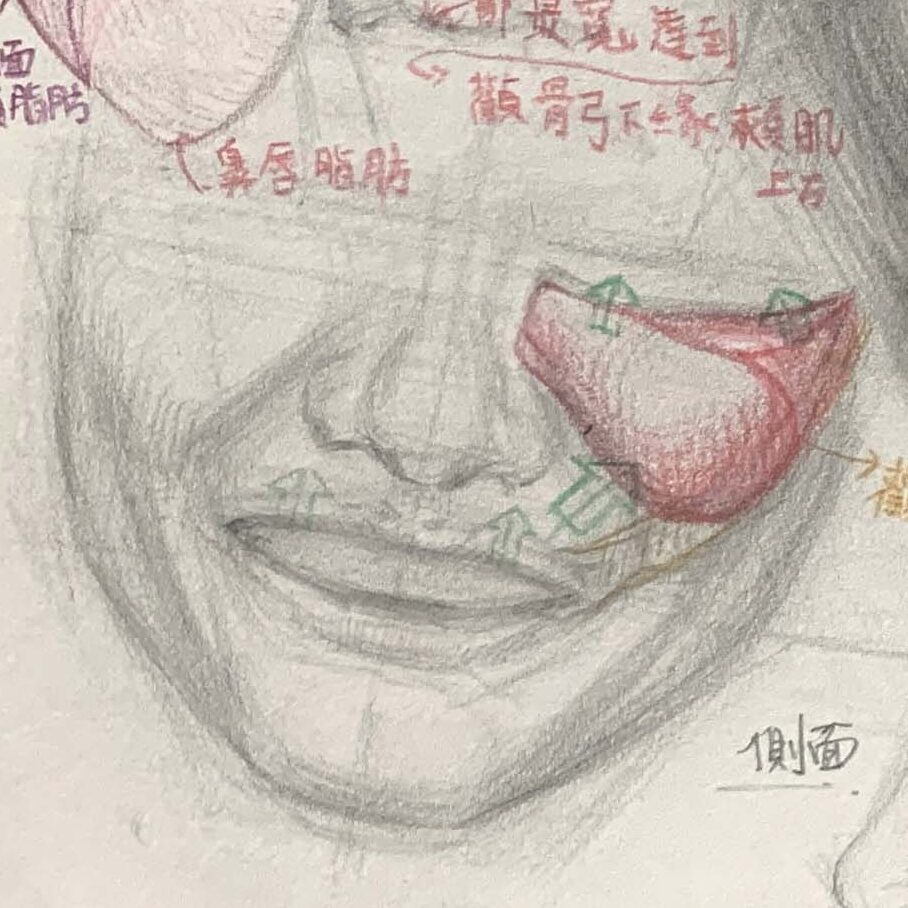
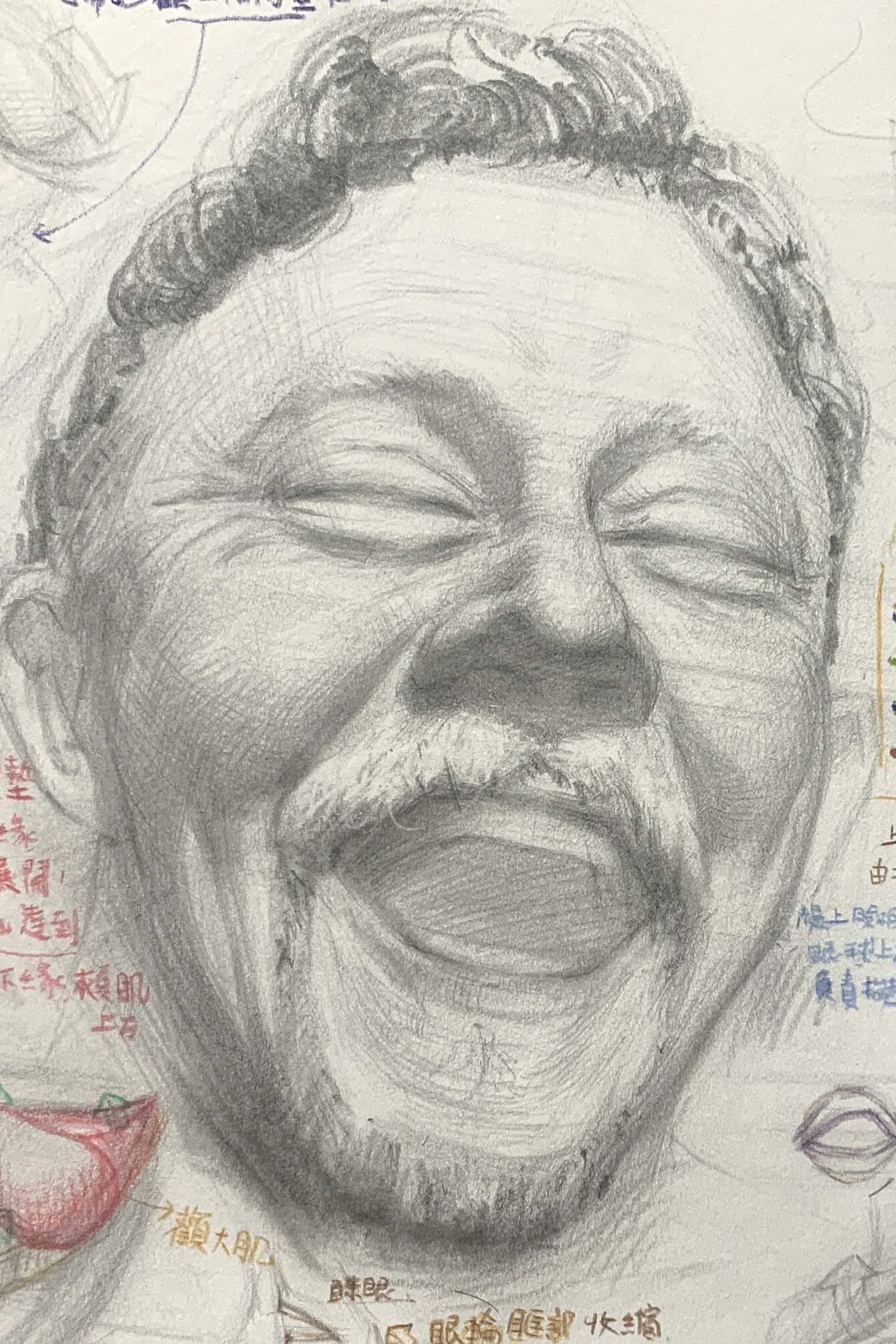
- Anger = corrugator + depressor supercilii + depressor anguli oris
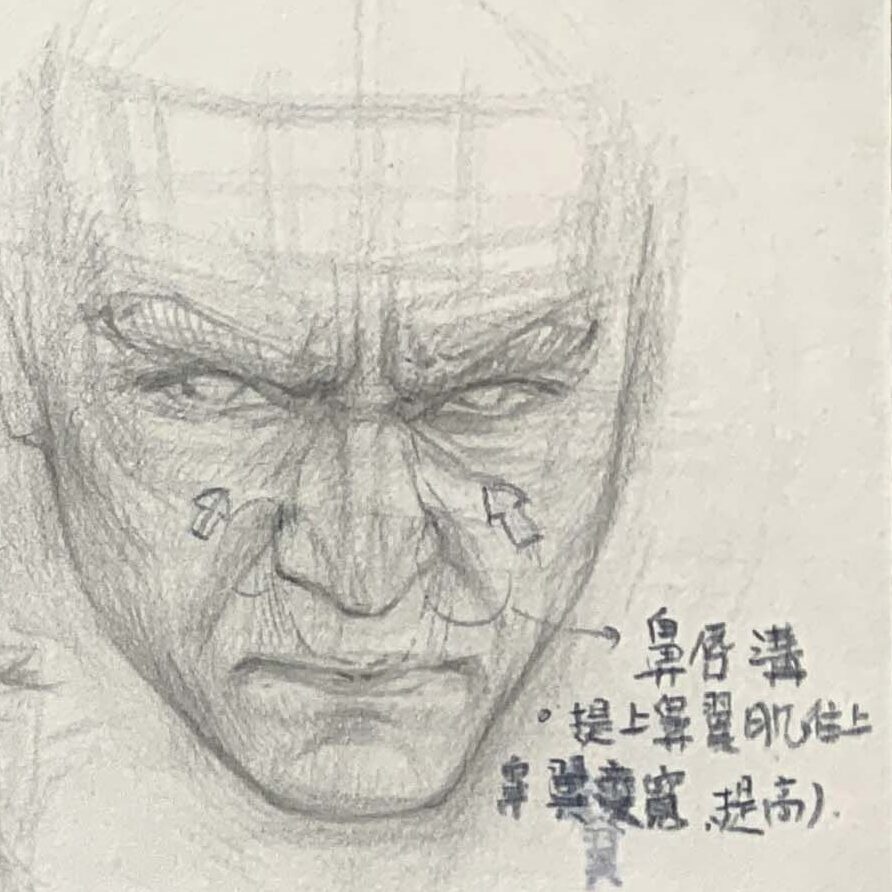
- Surprise = frontalis + relaxed orbicularis oculi + relaxed orbicularis oris
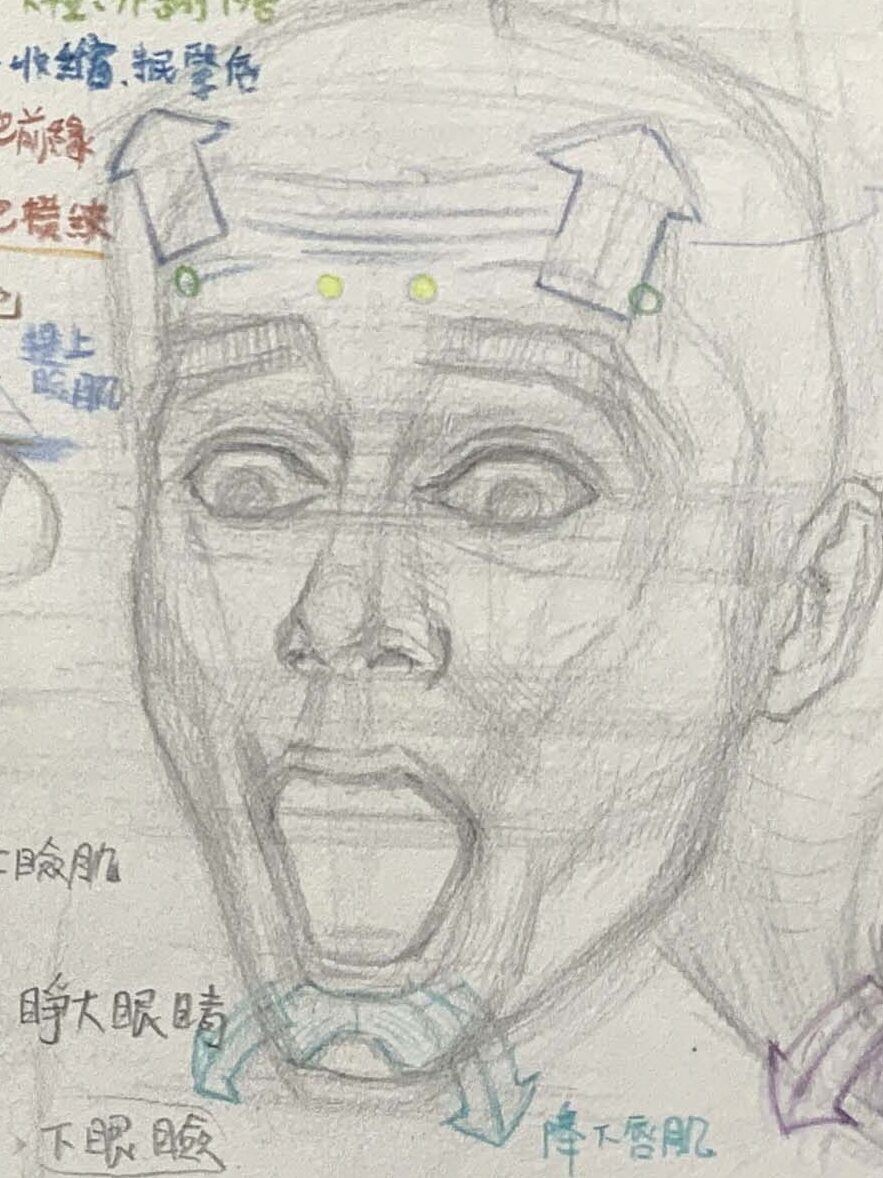
Forehead and eyebrow area muscles
Frontalis: pulls upward → surprised expression
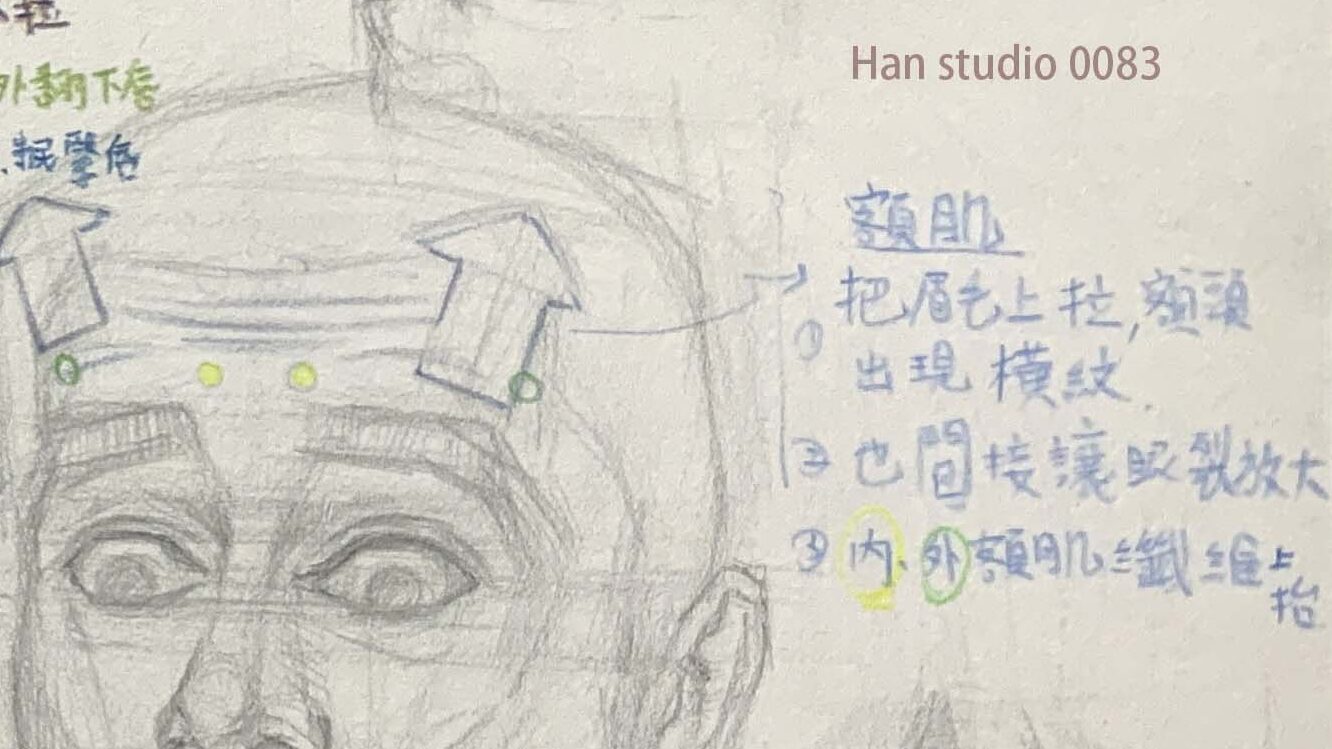
Corrugator + depressor supercilii: pull brows downward → angry or focused
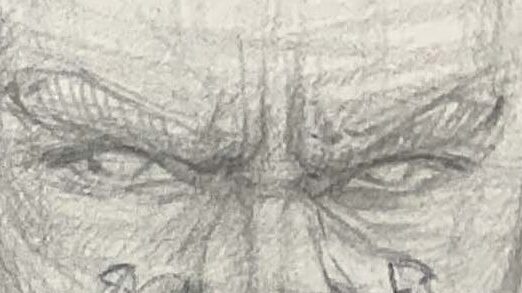
Action: tightly closed eyes, deep brow furrows
Mainly involves contraction of:
- Depressor supercilii → draws brows inward, vertical wrinkles appear.
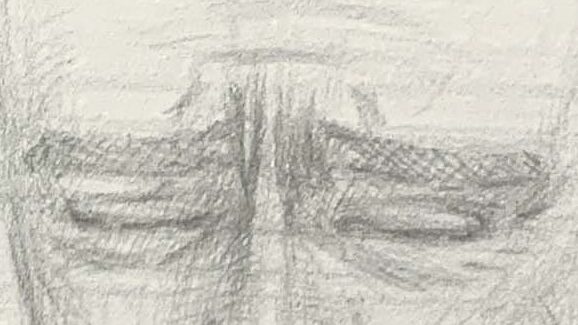
Location: below inner side of eyebrows, under forehead skin.
Action: pulls brows inward and downward, pinching glabellar skin to form “||” wrinkles.
Effect: deepens glabella depression, typical in anger/intense frown.
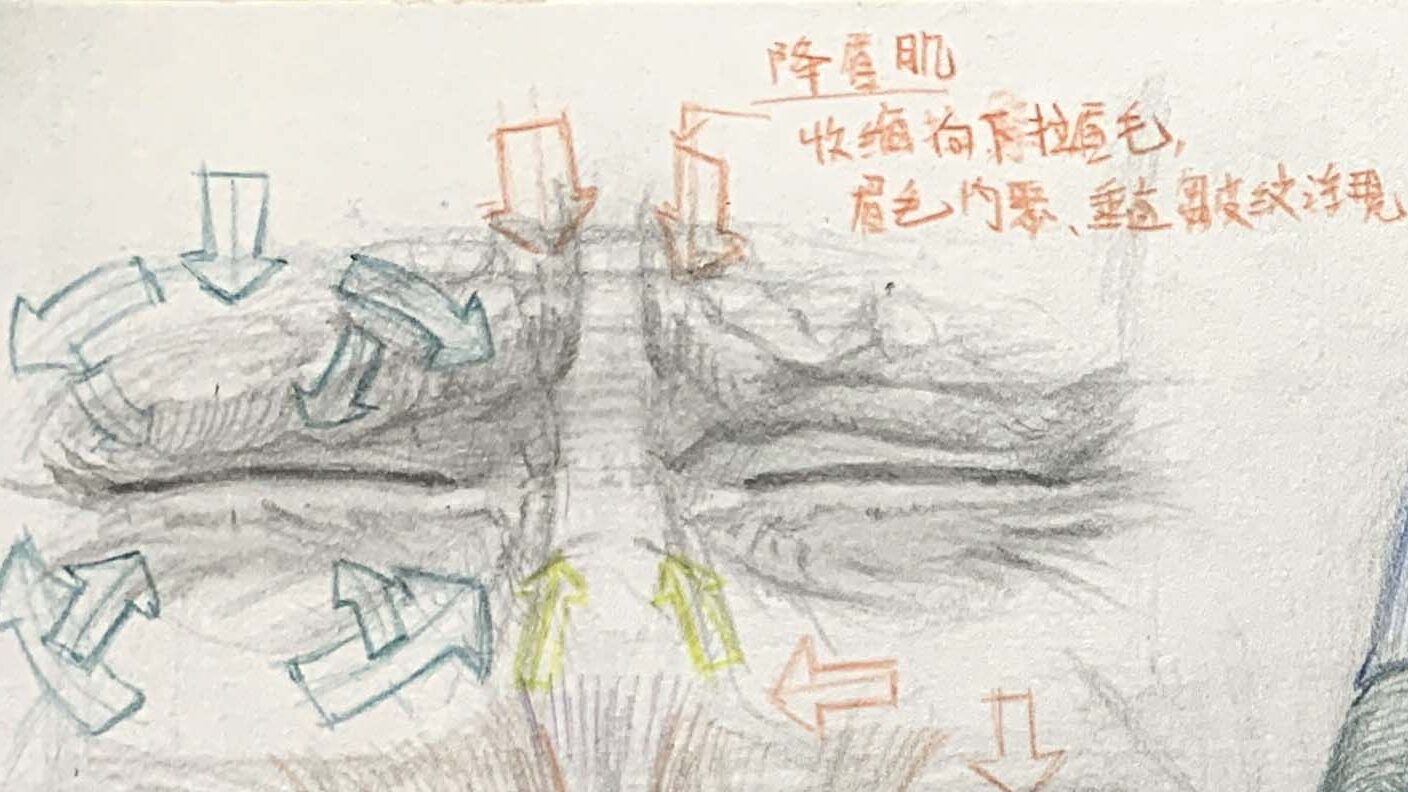
- Procerus contraction → adds transverse folds on nasal bridge.
- Orbicularis oculi (palpebral part) → closes eyelids, narrows eye slit.
動作Action: mild, natural blinking / half-closing the eyes, making the eyelids rest against the eyeball.
Action: gentle blinking, upper eyelid presses down, lower eyelid bulges slightly.
- Orbicularis oculi (orbital part) → pulls out crow’s feet, creates radiating wrinkles under brows and over cheeks.
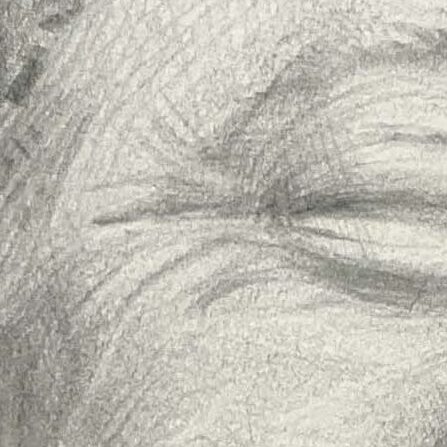
Action: during forceful squinting, the pull extends outward from the orbital rim, creating radiating fine wrinkles at the outer corner of the eye.
Action: strong squinting from orbital rim outward, forming fine lines at outer corners.
Drawing suggestion: observe brow angles and forehead wrinkle directions.
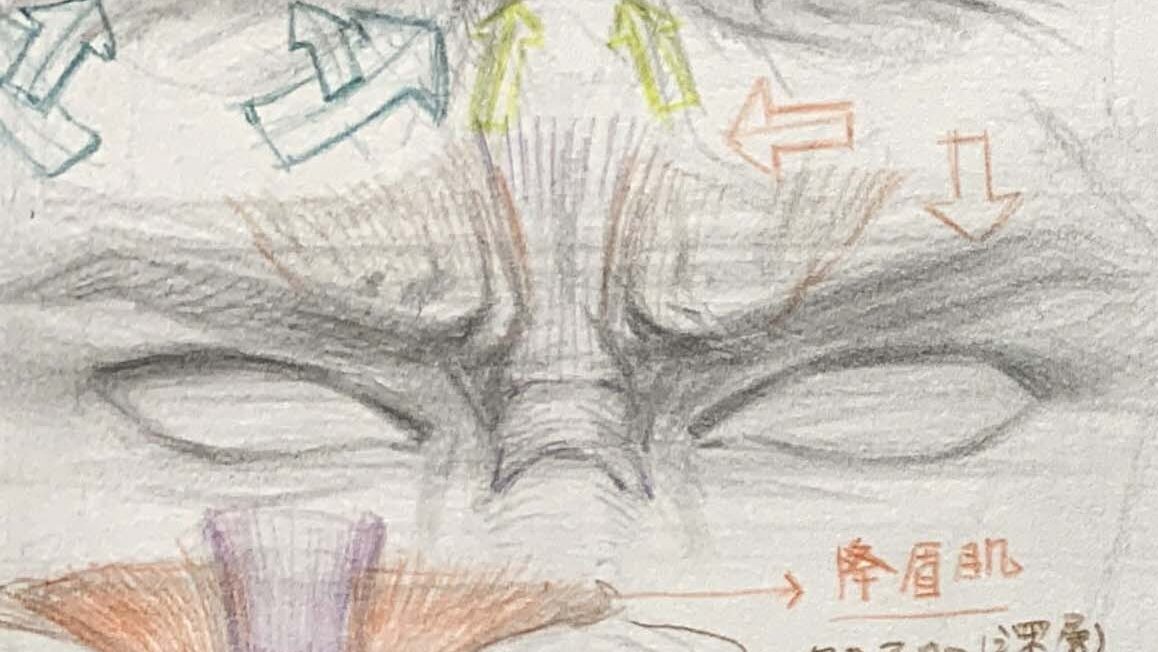
Eye muscles
- Orbicularis oculi: encircles eyes, closes or squints
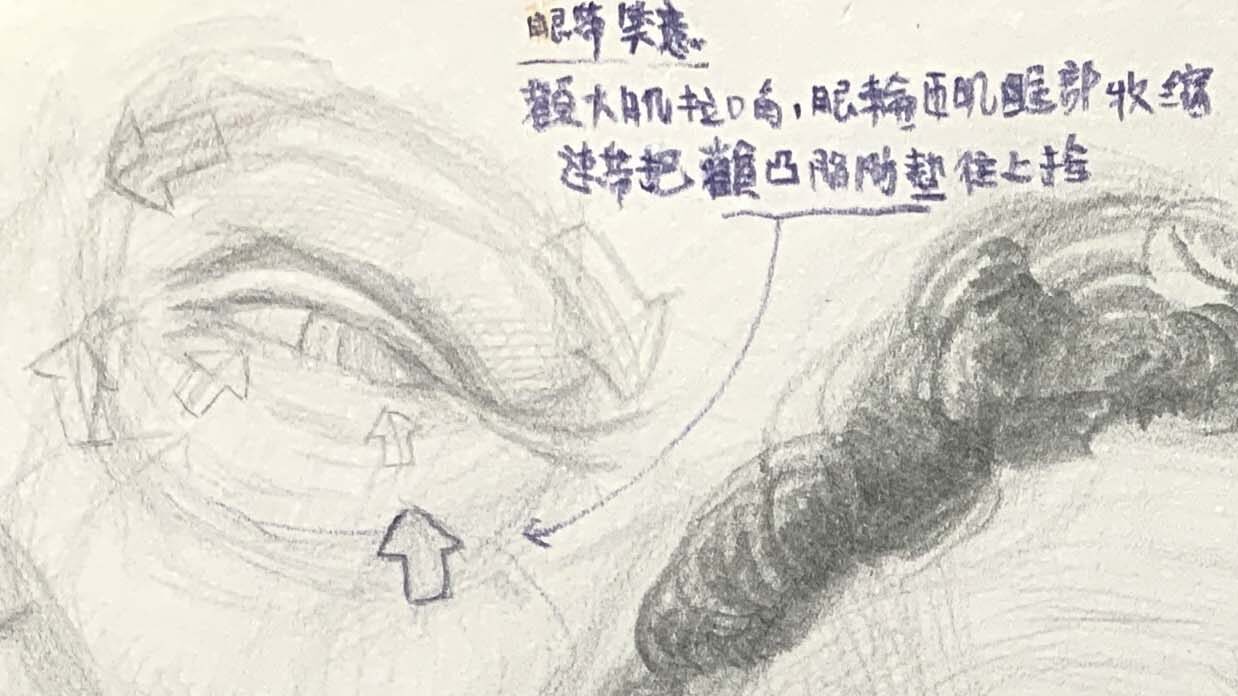
- Levator palpebrae superioris: opens eyes
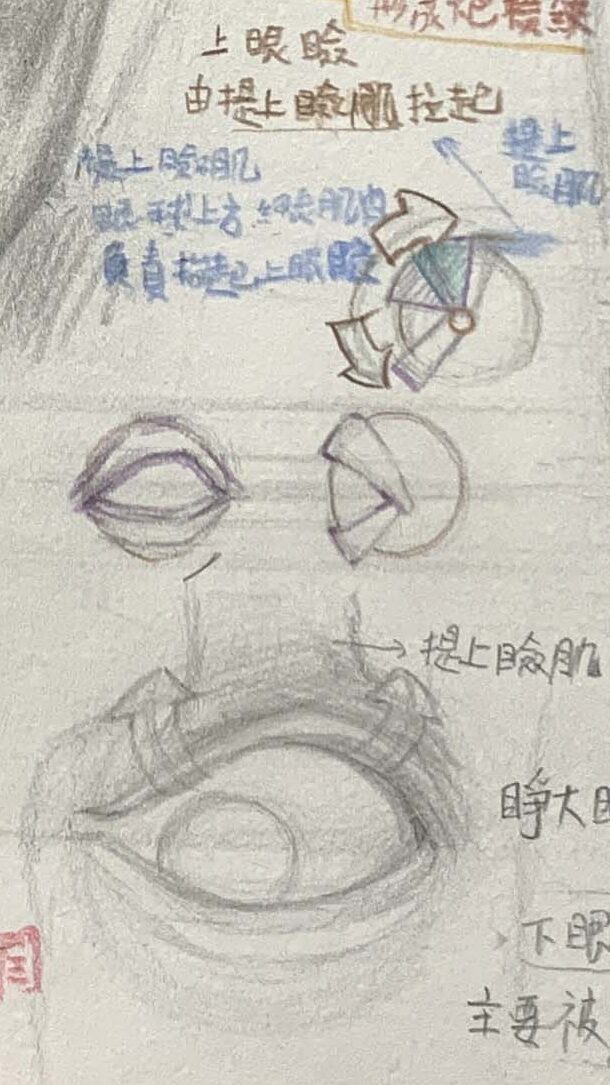
- Tip: when eyes close, upper lid presses down, lower lid bulges.
Nose muscles
- Depressor septi, levator labii superioris alaeque nasi: influence nostril tension, wrinkling
- Used in inhaling, disgust, contempt expressions.
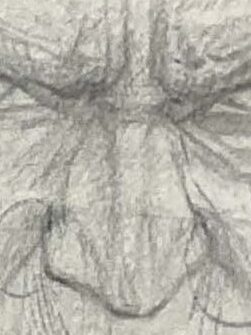
Lip and cheek muscles
- Orbicularis oris: contracts lips in circular shape (pouting, blowing)
Pouting relies on different orbicularis oris fiber layers plus the mentalis:
Contraction of the deep fibers of the orbicularis oris (upper incisor part).
- Deep fibers tighten lips inward
Contraction of the superficial fibers of the orbicularis oris (lower incisor part).
- Superficial fibers push lips forward, curling edges outward
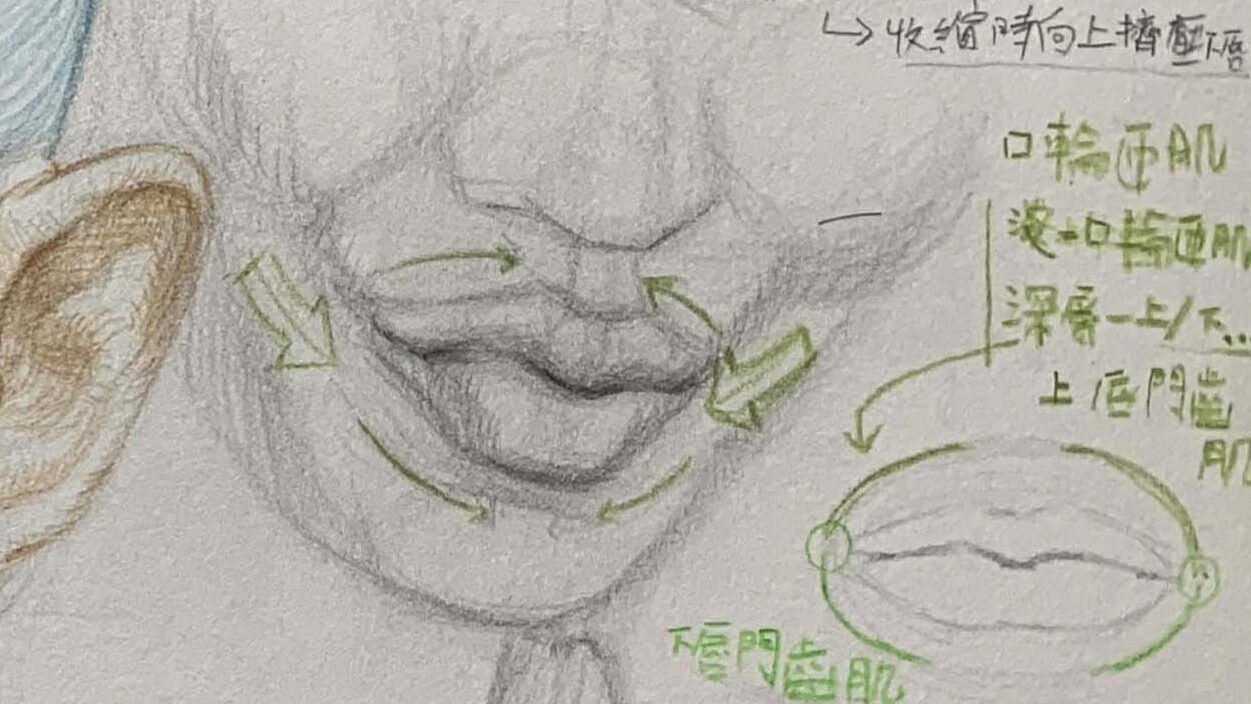
Mentalis:
- presses lower lip upward, enhances protrusion
Buccinator:
- stabilizes cheeks, supports lip pressure forward

- Levator anguli oris, risorius: raise mouth corners (happy, polite)
- Depressor anguli oris, mentalis: create sadness, drooping effect
- Tip: observe direction and proportion of corner muscles.

Chin and neck muscles
- Mentalis: involved in chin tightening, expresses sadness, endurance
- Sternocleidomastoid: neck muscle, important for tension and voice expression

- Tip: in exaggerated expressions, neck muscles pull strong visible lines.
Practice suggestion: from muscle charts to expression observation
Suggested approach as follows:
- Overlay muscle layers on blank face diagrams.
- Create 3–5 emotions: happy/angry/surprised/sad/disgust.
- Use arrows to show contraction directions and link expressions to muscle actions.
- Observe your own expressions with a mirror/selfies, especially mouth corners and brows.
Advanced: link dynamics to character design
- Expressions are not static — they’re continuous changes of muscle action.
- Suggested further study:
- Ex: “happiness” can be broken into: smile → laugh → brow-furrowed laugh.
- At each stage, observe which muscles act, which are passively pulled.
I hope this breakdown helps you better understand and appreciate facial muscle structures. If you have any questions or would like to explore specific topics, feel free to leave a comment or message me. Happy drawing!
―――――――――――――――――
If you're interested in learning to draw but don't know where to start, or if you'd like to understand the knowledge behind drawing,
feel free to join my LINE and contact me. In my classes, I organize drawing methods in a clear and structured way.
Click here to learn more about my drawing courses!
―――――――――――――――――
Other Related Portrait Sketching Articles:
How to Draw Arms: Learn Arm Movements and Bone Proportions
How to Draw Ears:Simplified Ear Structure and Shading Tips
How to Use Two-Tone Shading: Simple Shadow Techniques
How to Draw Masks: Use Perspective and Shadows
How to Accurately Master Hand Proportions and Joint Structure
Building Up from Simple Contours to Detailed Eye Portraits
Capturing Realism in Lip Drawing: Key Structures and Shading
Understanding the Three Key Elements of Head Structure
Mastering the basic proportions and structure of portrait drawing




Leave a Reply